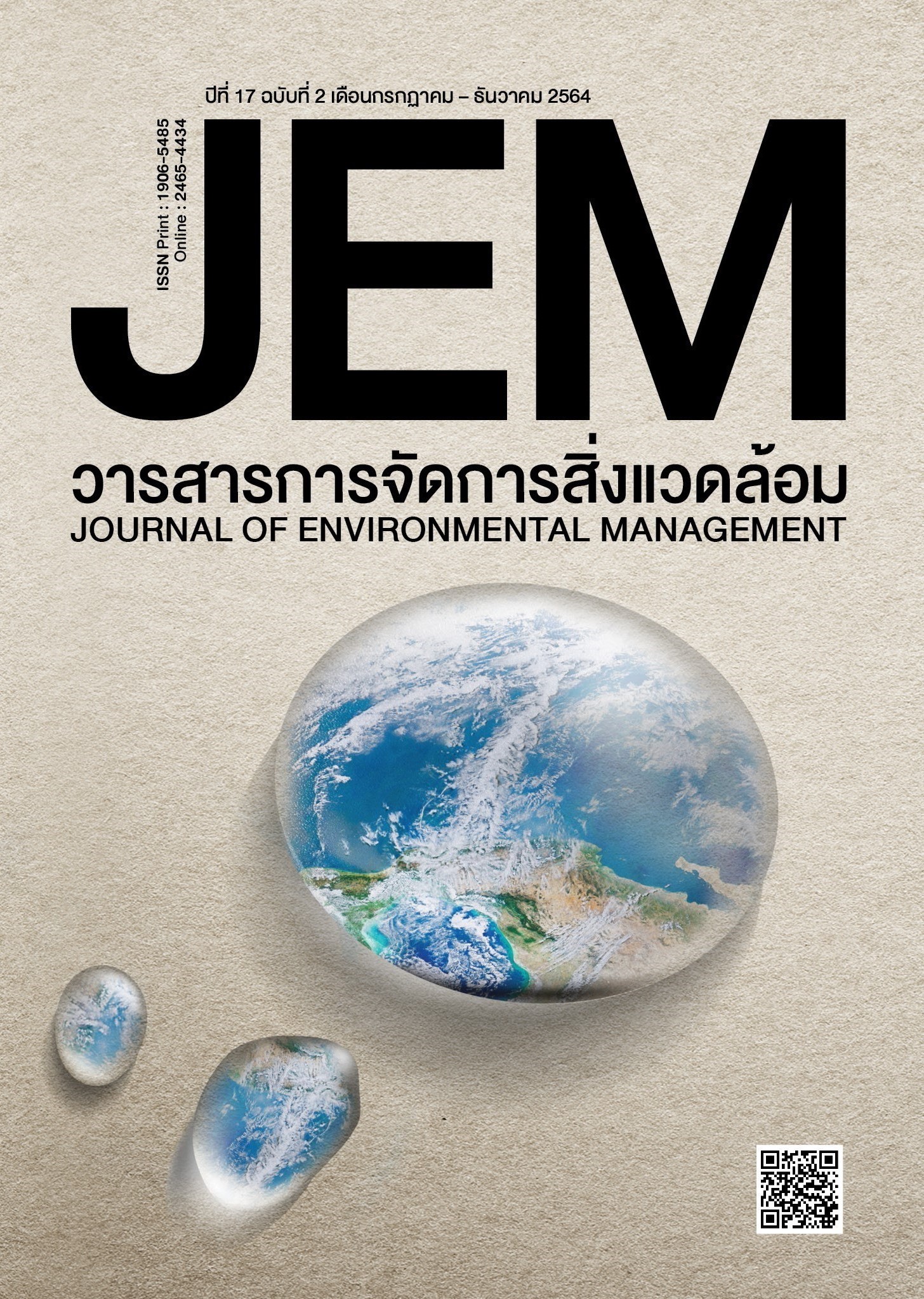ความเข้มฝนที่ส่งผลต่อการเกิดน้ำท่วม: กรณีศึกษาอำเภอเมืองเพชรบุรี จังหวัดเพชรบุรี
DOI:
https://doi.org/10.14456/jem.2021.8คำสำคัญ:
ความเข้มฝน, ปริมาณน้ำฝน, เหตุการณ์น้ำท่วมบทคัดย่อ
เหตุการณ์น้ำท่วมแต่ละครั้งได้สร้างความเสียหายและความยากลำบากในการใช้ชีวิตของผู้คนที่ประสบภัย การศึกษาครั้งนี้ศึกษาถึงความเข้มฝนที่มีผลทำให้เกิดเหตุการณ์น้ำท่วมอำเภอเมืองเพชรบุรี โดยใช้เหตุการณ์น้ำท่วมในพื้นที่อำเภอเมืองเพชรบุรี ระหว่างปี พ.ศ.2546-2559 รวมจำนวน 6 ครั้ง และใช้ข้อมูลปริมาณน้ำฝนรายวันจากสถานีตรวจวัดน้ำฝนของกรมอุตุนิยมวิทยา และกรมชลประทานจำนวน 11 สถานี ข้อมูลปริมาณน้ำท่ารายวันจากสถานีตรวจวัดน้ำท่าของกรมชลประทานจำนวน 6 สถานี ครอบคลุมพื้นที่ลุ่มน้ำเพชรบุรี และข้อมูลการขึ้น-ลงของน้ำทะเลของกรมเจ้าท่า จำนวน 1 สถานี ผลการศึกษาพบว่า ความเข้มฝนที่ทำให้เกิดน้ำท่วมในเขตอำเภอเมือง ได้แก่ ฝนตกสะสมสองวันในเขตอำเภอเมืองเกิน 100 มิลลิเมตร หรือฝนตกเหนือพื้นที่อำเภอเมืองเกิน 100 มิลลิเมตรต่อวันหรือฝนสะสมสองวันเกิน 200 มิลลิเมตร หรือปริมาณน้ำท่าไหลผ่านสถานี B.10 เกิน 150 ลูกบาศก์เมตรต่อวินาที นอกจากนี้ยังพบว่าระดับน้ำทะเลขึ้นสูงสุดที่ 3.90 เมตรจากระดับน้ำทะเลปานกลาง จะเป็นปัจจัยที่ทำให้น้ำไหลลงทะเลได้ช้าและเกิดการท่วมขังที่ยาวนานขึ้น ข้อมูลดังกล่าวเป็นประโยชน์ในการประเมินสถานการณ์และความรุนแรงของการเกิดน้ำท่วม ตลอดจนสามารถคาดการณ์เพื่อการแจ้งเตือนประชาชนให้มีการเตรียมความพร้อมต่อเหตุการณ์น้ำท่วมที่จะเกิดขึ้นได้
เอกสารอ้างอิง
Ashfaq, A., Jingzhong, Muhammad & Raza. (2017). Determinants of flood risk mitigation strategies at household level: a case of Khyber Pakhtunkhwa (KP) province, Pakistan. Springer, 88(1), 415-430.
Ashfaq, A., Jingzhong, Muhammad, Jahangir & Syed Muhammad. (2018). Flood hazards: household vulnerability and resilience in disaster-prone districts of Khyber Pakhtunkhwa province, Pakistan. Springer, 93(1), 147-165.
Ashfaq, A., Jingzhong, Rajib, Raza & Muhammad. (2019). Factors affecting flood-induced household vulnerability and health risks in Pakistan: The case of Khyber Pakhtunkhwa (KP) Province. International Journal of Disaster Risk Reduction, 42(101341), 1-8.
Hydro-Informatics Institute (Public Organization). (2019). Report of the flood situation [In Thai]. Retrieved January 12, 2020, from http://thaiwater.net/report.
Isaac, M., & Brian J. (2006). Robust responses of the hydrological cycle to global warming. Journal of climate, 19(21), 5686-5699.
Kanittha, Achara, Suparat, & Chawapornpan. (2016). A survey of flood disaster preparedness among hospitals in the central region of Thailand. Australasian Emergency Nursing Journal, 19(4), 191-197.
Nipon Tangtham. (1989). Measures to prevent flooding in forest ecology [In Thai]. Retrieved January 30, 2020, from https://kb.psu.ac.th/psukb/bitstream/2553/4403/41/ch1.pdf.
Office for Prevention and Mitigation Phetchaburi. (2019). Report of the flood situation [In Thai]. Retrieved January 12, 2020, from http://www.oic.go.th/
Richard, P., & Brian, J. (2008). Atmospheric warming and the amplification of precipitation extremes. Science, 321(5895), 1481-1484.
Robert, L., & Rod. (2012). Adapting to flood risk under climate change. SAGE Jurnal, 36(3), 348-378.Royal Irrigation Department. (2018). Water situation Water management and flood disaster risk[In Thai].
Retrieved January 20, 2020, from http://rid.go.th/main/index.php. Royal Irrigation Department. (2019). Hydro Information [In Thai]. Retrieved January 12, 2020, from http://rid.go.th/main/index.php.
Theerapong Saovaphak. (1996). Flood induced rainfall assessment from meteorological satellite data [In Thai]. Bangkok: Kasetsart University.
Water Resources Regional Office 7. (2019). Phetchaburi watershed [In Thai]. Retrieved January 18, 2020, from http://water.dwr.go.th/wrro7/index.php/th/.
Xiuquan, Guohe, & Brain,W. (2016). Dynamically-downscaled probabilistic projections of precipitation changes: A Canadian case study. Environmental research, 148, 86-101.
Xiuquan, Guohe, & Jinliang. (2014). Projected increases in intensity and frequency of rainfall extremes through a regional climate modeling approach. Journal of Geophysical Research, 119(23), 13,271-13,286.
Yukiko, Roobavannan, Sujan, Lisako, Dai, Satoshi, Hyungjun, & Shinjiro. (2013). Global flood risk under climate change. Nature Climate Change, 3, 816-821.



